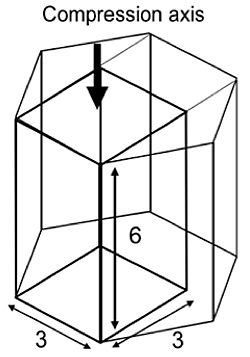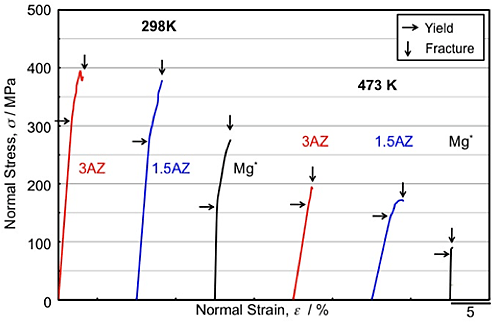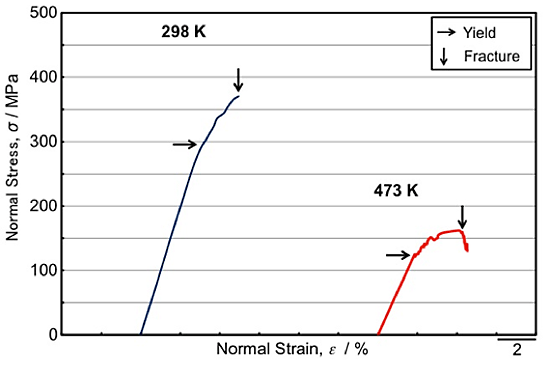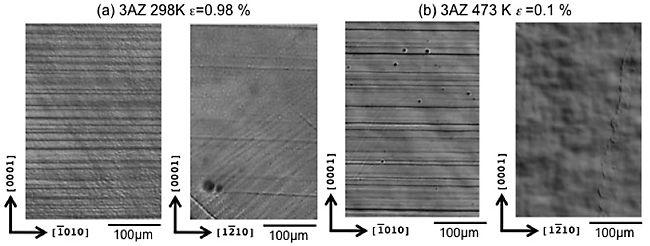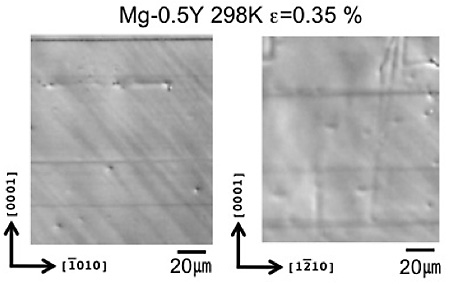Magnesium alloys are being used in structural applications in the automotive filed due to their high specific strength. Then, it is important to understand the deformation mechanism of yielding in metals to improve their plasticity. In hcp metals, (0001) basal slip and (1010) prismatic slip are well known as main slip systems. According to the von-Mises criterion, another non-basal slip systems must be activated to deform the polycrystalline materials uniformly. It has been reported that {1122}<1123> second order pyramidal slip is activated in magnesium single crystals.
Generally magnesium is used as magnesium alloys. Zinc and aluminum are major alloying element of them all. The effect of aluminum and zinc addition on deformation behavior in magnesium single crystals was reported. However, the effect of zinc and aluminum on non-basal slip in magnesium is not well known. Recently, it has been reported that Mg-Y alloy system exhibits improved ductility by enhanced activity of non-basal slip. With these viewpoints, the aim of this work is to investigate active non-basal slip system by using Mg-Al-Zn alloy and Mg-Y single crystals in [0001] compression test.
Mg-Y and Mg-Al-Zn alloy single crystals were grown by unidirectional solidification method. Two types of specimens in which wide surface are basal and prismatic plane were prepared.
Figure 1 shows test specimen used in this study. Size of the specimen was about 3 mm ![]() 3 mm
3 mm ![]() 6 mm and compression axis was [0001]. Compositions of the specimen were Mg-0.5at%Y (refers as 0.5Y), Mg-1.45at%Al-0.15at%Zn (refers as 1.5AZ) and Mg-2.7at%Al-0.4at%Zn (refers as 3AZ). The latter is corresponding to commercial AZ31. Testing temperature were 298K and 473K, and nominal strain rate was 1.4
6 mm and compression axis was [0001]. Compositions of the specimen were Mg-0.5at%Y (refers as 0.5Y), Mg-1.45at%Al-0.15at%Zn (refers as 1.5AZ) and Mg-2.7at%Al-0.4at%Zn (refers as 3AZ). The latter is corresponding to commercial AZ31. Testing temperature were 298K and 473K, and nominal strain rate was 1.4![]() 10-4/s.
10-4/s.
Figure 2 and Figure 3 show stress![]() strain curves of Mg-Al-Zn and Mg-Y single crystals, respectively. At 298K, Mg-Y and Mg-Zn-Al single crystals showed quickly strain hardening and fractured as much as 1% strain. At 473K, yield stress of Mg-Al-Zn alloys decreased and the alloys showed similar deformation behavior at 298K. On the other hand, Mg-0.5Y alloy single crystals showed low strain hardening compared to Mg-Al-Zn single crystals.
strain curves of Mg-Al-Zn and Mg-Y single crystals, respectively. At 298K, Mg-Y and Mg-Zn-Al single crystals showed quickly strain hardening and fractured as much as 1% strain. At 473K, yield stress of Mg-Al-Zn alloys decreased and the alloys showed similar deformation behavior at 298K. On the other hand, Mg-0.5Y alloy single crystals showed low strain hardening compared to Mg-Al-Zn single crystals.
Figure 4 and Figure 5 show slip lines observed at 298K and 473K in 3AZ and 0.5Y, respectively. In both alloys, slip lines on (1210) were parallel to basal plane or inclined about 54 degrees. In the case of (1010) observation, slip lines were inclined about 39 degrees to basal plane or very few slip lines were observed compare to (1210). These results indicate that all specimens were yielded and deformed by {1122}<1123> secondary pyramidal slip.
Figure 6 shows temperature dependence of the yield stress and the ductility. Values of pure magnesium are also plotted in the figure to identify the effect of alloying elements. Both alloys show strong negative temperature dependence of the yield stress. The yield stresses were increased more than 100MPa at 298K and 50MPa at 473K by addition of alloy elements. While amount of alloy element of 0.5Y is much smaller than that of 3AZ and 1.5AZ, increase of the yield stress is similar. Namely, effect of yttrium to CRSS of pyramidal slip is stronger than aluminum or zinc. Ductility in [0001] compression of pure magnesium single crystal decrease with increasing temperature since {1011}-{1012} double twin occurs at high temperature and crack will occur by the double twin. Ductility of 0.5Y was higher than pure magnesium at high temperature, therefore, yttrium would have an effect for activity of the double twin.
